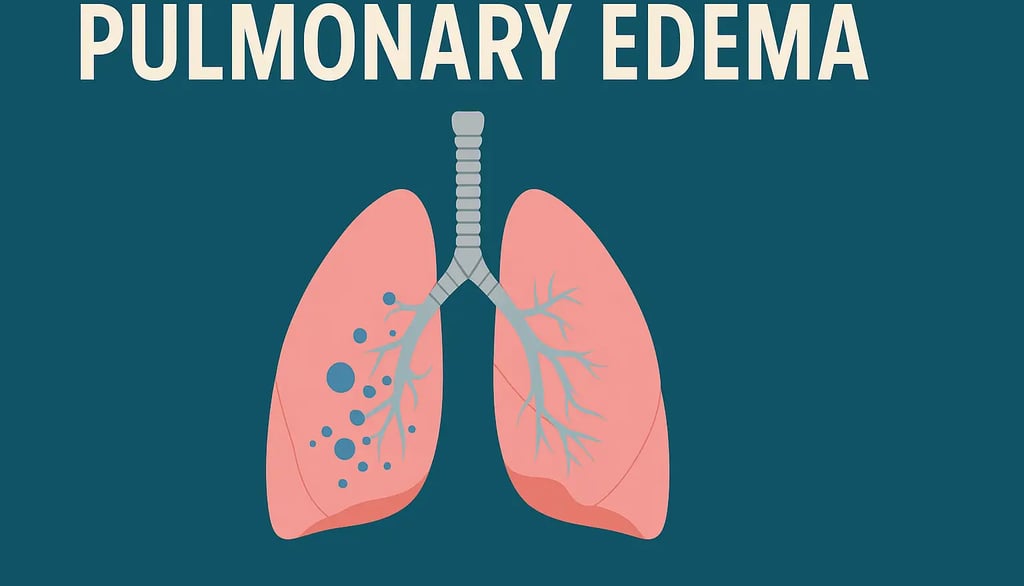Pulmonary Edema: Causes, Symptoms, and Treatment Explained
Learn all about pulmonary edema—its causes, symptoms, and effective treatment options. Understand how to identify and manage this serious lung condition early.


What is Pulmonary Edema?
Pulmonary edema is a serious medical condition marked by the accumulation of excess fluid in the lungs, which hinders normal respiratory function. This fluid collects in the alveoli—the small air sacs in the lungs—making it difficult for oxygen to pass into the bloodstream. As a result, patients experience shortness of breath, low oxygen levels, and, in severe cases, respiratory failure.
Pulmonary edema is broadly classified into two types:
Cardiogenic pulmonary edema – caused by heart-related issues, such as congestive heart failure (CHF) or myocardial infarction, which raise pressure in pulmonary blood vessels.
Non-cardiogenic pulmonary edema – results from conditions like infections, toxin exposure, or acute respiratory distress syndrome (ARDS), which increase lung inflammation and capillary leakage.
If left untreated, pulmonary edema can escalate rapidly, posing life-threatening risks. Recognizing its symptoms and seeking prompt medical care is crucial, especially for individuals with pre-existing heart or lung conditions.
Causes of Pulmonary Edema
Understanding the underlying causes of pulmonary edema is key to accurate diagnosis and effective treatment. Causes fall into two main categories:
1. Cardiogenic Causes
Cardiogenic pulmonary edema occurs due to impaired heart function. The most common cause is congestive heart failure (CHF), where the heart cannot pump blood efficiently. This leads to increased pressure in the pulmonary capillaries, pushing fluid into the lungs.
Other cardiogenic causes include:
Heart valve disorders
Arrhythmias (irregular heartbeat)
Myocardial infarction (heart attack)
2. Non-Cardiogenic Causes
This type results from non-heart-related factors, such as:
Pneumonia or severe lung infections
Toxin or chemical inhalation
Acute respiratory distress syndrome (ARDS)
High-altitude pulmonary edema (HAPE) – fluid builds up in the lungs due to low oxygen and high pulmonary artery pressure at high altitudes
Risk Factors
Several factors can increase the risk of developing pulmonary edema:
Pre-existing heart or lung disease
Kidney problems
High-altitude travel
Exposure to environmental toxins
Sedative overdose or trauma
Recognizing these causes and risk factors can support early intervention and improved treatment outcomes.
Common Symptoms of Pulmonary Edema
The symptoms of pulmonary edema may develop suddenly or gradually, depending on its underlying cause and severity. Key symptoms include:
1. Breathing Difficulties
Shortness of breath, especially during exertion or when lying flat (orthopnea)
Wheezing or gasping for air
Rapid, shallow breathing (tachypnea)
2. Cough and Chest Symptoms
Persistent cough, often producing frothy or pink-tinged sputum
Chest tightness or discomfort
Audible crackles or rales in the lungs
3. Oxygen Deficiency Signs
Cyanosis – bluish lips, skin, or fingertips due to low oxygen levels
Clammy skin, excessive sweating
Anxiety, restlessness, or confusion
These symptoms require immediate medical attention, as acute pulmonary edema can be fatal if not treated promptly.
Treatment Options for Pulmonary Edema
Effective treatment for pulmonary edema involves addressing the root cause, relieving symptoms, and restoring normal lung function. Treatment strategies include:
1. Emergency Medical Care
In severe or acute cases, immediate hospitalization is required. Treatment options may include:
Oxygen therapy – to increase blood oxygen levels
Mechanical ventilation or intubation, if necessary
2. Medications
Diuretics (e.g., furosemide) – help eliminate excess fluid through urination
Heart medications – such as ACE inhibitors, beta-blockers, or nitroglycerin, used for heart failure
Morphine – to reduce anxiety and the sensation of breathlessness (in some cases)
3. Addressing Underlying Conditions
Treat infections with antibiotics in cases related to pneumonia
Manage kidney issues or correct toxin exposure
Treat ARDS with supportive care, including ventilators and corticosteroids (if indicated)
Lifestyle and Preventive Measures
Long-term management of pulmonary edema focuses on preventing recurrence and improving overall health:
Follow a low-sodium, heart-healthy diet
Maintain a healthy weight and exercise regularly
Avoid smoking and alcohol
Manage chronic conditions, such as hypertension or diabetes
Limit travel to high altitudes if at risk
Regular check-ups and medication adherence are also essential for those with heart or lung disease.
Conclusion
Pulmonary edema is a life-threatening condition that demands timely diagnosis and prompt treatment. Whether triggered by heart failure, lung infections, or environmental factors, it significantly impacts respiratory function and overall health. Recognizing early symptoms like shortness of breath, wheezing, and frothy sputum can help individuals seek life-saving medical care. With proper treatment, lifestyle changes, and preventive care, patients can effectively manage pulmonary edema and lead a healthier life.
Frequently asked questions
❓What is pulmonary edema?
Answer: Pulmonary edema is a serious lung condition where fluid builds up in the air sacs (alveoli), making it hard to breathe and reducing oxygen levels in the body.
❓Can pulmonary edema be fatal?
Answer: Yes, if left untreated, pulmonary edema can quickly become life-threatening due to lack of oxygen and respiratory failure.
❓What causes pulmonary edema?
Answer: It can be caused by heart failure (cardiogenic) or lung-related issues like infections, toxins, high altitudes, or acute respiratory distress (non-cardiogenic).
❓How is pulmonary edema treated?
Answer: Treatment involves oxygen therapy, diuretics to remove excess fluid, and medications to manage the underlying heart or lung condition.
❓What are the warning signs of pulmonary edema?
Answer: Common symptoms include shortness of breath, frothy or pink sputum, wheezing, rapid breathing, and bluish lips or skin.
